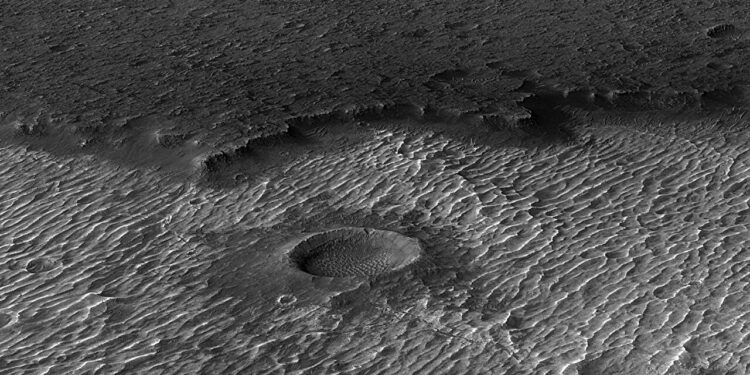Paleomegaripples, observed on Terra Sirenum on Mars by the High-Resolution Imaging science experiment, have consistent peak wavelengths, numerous fractures and craters, and may be partially covered by ancient lava flows. Credit: NASA/JPL/University of Arizona.
Long ago, wind and water shaped the soft sand and sediment of Mars into dunes, ripples, and other landforms called coastlines. Over billions of years, some of these landforms solidified into rock, which scientists call paleocoastlines. Frozen in time, changes occur only as slow erosion by dusty winds, burial by ancient lava flows, or the occasional meteorite impact.
A team of researchers led by Matthew Chojnacki, a senior scientist at the Planetary Science Institute, mapped and characterized the paleobeds of the Red Planet to better understand their diversity and Mars’ ancient climate. The study was published in the journal Geomorphology.
Since 2013, Chojnacki has worked on HiRISE, the high-resolution imaging science experiment on NASA’s Mars Reconnaissance Orbiter, or MRO.
“I put together a collection of HiRISE images that showed strange features that looked like bedforms, but they were cratered and covered in rocks. They looked decrepit and fossilized,” Chojnacki said. “We wanted to investigate further.”
Their research has uncovered paleoshorelines in landscapes of varying ages, latitudes, and geological settings, including craters, canyons, and basins. They can be classified into groups called paleodunes and paleomegaripples, which were shaped by wind; fluvial paleodunes, which were shaped by water; and dune pits, which were paleodunes that had been so eroded that only a shallow depression remained.
Paleobeds have been found all over the planet, but most were concentrated in the Valles Marineris and Athabasca Valles, near the equator; Noctis Labyrinthus, west of Valles Marineris; Arcadia Planitia in the northern lowlands; Hellas Planitia in the southern hemisphere and the highland-lowland transition between Arabia Terra and Apollinaris Mons.
“The most compelling and obvious paleoshoreline features were dunes,” Chojnacki said. “A lot of these paleodunes look like modern dunes, they just look more decrepit.”
The most common paleo-bedforms are paleo-megaripples, which look like large fields of parallel ridges. These smaller bedforms occur when wind blows over abundant coarse sand.
“Paleomegaripples are also compelling, but slightly less so than dunes, because there are other geological processes that could have formed similar landforms,” Chojnacki said.
Based on what the team knew about modern megaripples, they proposed an evolutionary model for these features: Wind first shapes them, then eventually stops, allowing the sand to harden and cement into rock, leading to their preservation and eventual degradation.
The rarest and most degraded paleobeds were likely shaped by ancient water, called paleofluvial beds. The team found these forms only in what are thought to be the remains of ancient megafloods.
Chojnacki said he was surprised they hadn’t found more of these paleo-fluvial beds.
“Mars has an abundance of dry riverbeds where other riverbed forms could have formed, but it appears that their small size and the filling of the beds was not conducive to their preservation,” he said.
The team estimates that most paleoshorelines were cemented into the geological record about 2 billion years ago or more recently. Most shorelines were likely buried after they were formed and transported, possibly by volcanic activity such as lava flows or ash falls, until erosion revealed them again, while others were cemented into the rock without ever being buried.
“In other cases, active sand dunes along the northern polar cap migrate over older paleodunes, causing them to erode. Seasonal ice can also erode dunes,” Chojnacki said. “The variety of these bedforms speaks to the diversity of dynamics and conditions at work in the solar system.”
Now that this study has revealed a large sample of paleobedforms on Mars, the team hopes to identify modern dune fields that might be trending in a similar direction.
“While many Martian layers are active and migrating today, other fields are static and show signs of a stabilization process that could eventually lead to lithification,” Chojnacki said. “Understanding this continuum will hopefully give us a better understanding of how climate conditions on the Red Planet have evolved.”
More information:
Matthew Chojnacki et al., Global study of paleo-bedforms on Mars, Geomorphology (2024). DOI: 10.1016/j.geomorph.2024.109428
Provided by the Planetary Science Institute
Quote:Frozen in time: Rock fossils suggest Mars’ ancient climate (2024, September 25) retrieved September 26, 2024 from
This document is subject to copyright. Apart from any fair dealing for the purpose of private study or research, no part may be reproduced without written permission. The content is provided for informational purposes only.



